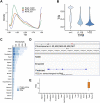Prediction of transcript isoforms in 19 chicken tissues by Oxford Nanopore long-read sequencing
- PMID: 36246588
- PMCID: PMC9561881
- DOI: 10.3389/fgene.2022.997460
Prediction of transcript isoforms in 19 chicken tissues by Oxford Nanopore long-read sequencing
Abstract
To identify and annotate transcript isoforms in the chicken genome, we generated Nanopore long-read sequencing data from 68 samples that encompassed 19 diverse tissues collected from experimental adult male and female White Leghorn chickens. More than 23.8 million reads with mean read length of 790 bases and average quality of 18.2 were generated. The annotation and subsequent filtering resulted in the identification of 55,382 transcripts at 40,547 loci with mean length of 1,700 bases. We predicted 30,967 coding transcripts at 19,461 loci, and 16,495 lncRNA transcripts at 15,512 loci. Compared to existing reference annotations, we found ∼52% of annotated transcripts could be partially or fully matched while ∼47% were novel. Seventy percent of novel transcripts were potentially transcribed from lncRNA loci. Based on our annotation, we quantified transcript expression across tissues and found two brain tissues (i.e., cerebellum and cortex) expressed the highest number of transcripts and loci. Furthermore, ∼22% of the transcripts displayed tissue specificity with the reproductive tissues (i.e., testis and ovary) exhibiting the most tissue-specific transcripts. Despite our wide sampling, ∼20% of Ensembl reference loci were not detected. This suggests that deeper sequencing and additional samples that include different breeds, cell types, developmental stages, and physiological conditions, are needed to fully annotate the chicken genome. The application of Nanopore sequencing in this study demonstrates the usefulness of long-read data in discovering additional novel loci (e.g., lncRNA loci) and resolving complex transcripts (e.g., the longest transcript for the TTN locus).
Keywords: annotation; chicken; long-read sequencing; nanopore; transcript isoform; transcriptome.
Copyright © 2022 Guan, Halstead, Islas-Trejo, Goszczynski, Cheng, Ross and Zhou.
Conflict of interest statement
The authors declare that the research was conducted in the absence of any commercial or financial relationships that could be construed as a potential conflict of interest.
Figures





Similar articles
-
Prediction of transcript isoforms and identification of tissue-specific genes in cucumber.BMC Genomics. 2025 Jan 10;26(1):25. doi: 10.1186/s12864-025-11212-w. BMC Genomics. 2025. PMID: 39794760 Free PMC article.
-
Transcriptome annotation of 17 porcine tissues using nanopore sequencing technology.Anim Genet. 2023 Feb;54(1):35-44. doi: 10.1111/age.13274. Epub 2022 Nov 16. Anim Genet. 2023. PMID: 36385508
-
Large-Scale Multiplexing Permits Full-Length Transcriptome Annotation of 32 Bovine Tissues From a Single Nanopore Flow Cell.Front Genet. 2021 May 20;12:664260. doi: 10.3389/fgene.2021.664260. eCollection 2021. Front Genet. 2021. PMID: 34093657 Free PMC article.
-
Long-Read Sequencing Revealed an Extensive Transcript Complexity in Herpesviruses.Front Genet. 2018 Jul 17;9:259. doi: 10.3389/fgene.2018.00259. eCollection 2018. Front Genet. 2018. PMID: 30065753 Free PMC article. Review.
-
Long-Read Sequencing - A Powerful Tool in Viral Transcriptome Research.Trends Microbiol. 2019 Jul;27(7):578-592. doi: 10.1016/j.tim.2019.01.010. Epub 2019 Feb 26. Trends Microbiol. 2019. PMID: 30824172 Review.
Cited by
-
Genetic regulation of gene expression across multiple tissues in chickens.Nat Genet. 2025 May;57(5):1298-1308. doi: 10.1038/s41588-025-02155-9. Epub 2025 Apr 8. Nat Genet. 2025. PMID: 40200121
-
Prediction of transcript isoforms and identification of tissue-specific genes in cucumber.BMC Genomics. 2025 Jan 10;26(1):25. doi: 10.1186/s12864-025-11212-w. BMC Genomics. 2025. PMID: 39794760 Free PMC article.
-
Full-length transcriptome sequencing of pepper fruit during development and construction of a transcript variation database.Hortic Res. 2024 Jul 24;11(9):uhae198. doi: 10.1093/hr/uhae198. eCollection 2024 Sep. Hortic Res. 2024. PMID: 39257544 Free PMC article.
-
Enriched atlas of lncRNA and protein-coding genes for the GRCg7b chicken assembly and its functional annotation across 47 tissues.Sci Rep. 2024 Mar 19;14(1):6588. doi: 10.1038/s41598-024-56705-y. Sci Rep. 2024. PMID: 38504112 Free PMC article.
-
The Abundant and Unique Transcripts and Alternative Splicing of the Artificially Autododecaploid London Plane (Platanus × acerifolia).Int J Mol Sci. 2023 Sep 23;24(19):14486. doi: 10.3390/ijms241914486. Int J Mol Sci. 2023. PMID: 37833935 Free PMC article.

